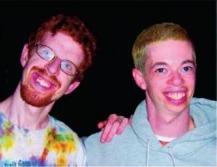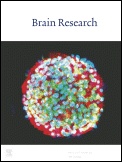
Dyslexia, also known until the 1960s as word blindness, is a learning disability that affects reading. Different people are affected to different degrees. Problems may include difficulties in spelling words, reading quickly, writing words, "sounding out" words in the head, pronouncing words when reading aloud and understanding what one reads. Often these difficulties are first noticed at school. The difficulties are involuntary, and people with this disorder have a normal desire to learn. People with dyslexia have higher rates of attention deficit hyperactivity disorder (ADHD), developmental language disorders, and difficulties with numbers.

Developmental psychology is the scientific study of how and why humans grow, change, and adapt across the course of their lives. Originally concerned with infants and children, the field has expanded to include adolescence, adult development, aging, and the entire lifespan. Developmental psychologists aim to explain how thinking, feeling, and behaviors change throughout life. This field examines change across three major dimensions, which are physical development, cognitive development, and social emotional development. Within these three dimensions are a broad range of topics including motor skills, executive functions, moral understanding, language acquisition, social change, personality, emotional development, self-concept, and identity formation.

Williams syndrome (WS), also Williams–Beuren syndrome (WBS), is a genetic disorder that affects many parts of the body. Facial features frequently include a broad forehead, underdeveloped chin, short nose, and full cheeks. Mild to moderate intellectual disability is observed in people with WS, with particular challenges with visual spatial tasks such as drawing. Verbal skills are relatively unaffected. Many people with WS have an outgoing personality, an openness to engaging with other people, and a happy disposition. Medical issues with teeth, heart problems, and periods of high blood calcium are common.

Piaget's theory of cognitive development is a comprehensive theory about the nature and development of human intelligence. It was originated by the Swiss developmental psychologist Jean Piaget (1896–1980). The theory deals with the nature of knowledge itself and how humans gradually come to acquire, construct, and use it. Piaget's theory is mainly known as a developmental stage theory.

David Cyril Geary is a United States cognitive developmental and evolutionary psychologist with interests in mathematical learning and sex differences. He is currently a Curators’ Professor and Thomas Jefferson Fellow in the Department of Psychological Sciences and Interdisciplinary Neuroscience Program at the University of Missouri in Columbia, Missouri.
Keith E. Stanovich is a Canadian psychologist. He is an Emeritus Professor of Applied Psychology and Human Development at the University of Toronto and former Canada Research Chair of Applied Cognitive Science. His research areas are the psychology of reasoning and the psychology of reading. His research in the field of reading was fundamental to the emergence of today's scientific consensus about what reading is, how it works, and what it does for the mind. His research on the cognitive basis of rationality has been featured in the journal Behavioral and Brain Sciences and in recent books by Yale University Press and University of Chicago Press. His book What Intelligence Tests Miss won the 2010 Grawemeyer Award in Education. He received the 2012 E. L. Thorndike Career Achievement Award from the American Psychological Association.

Developmental Biology is a peer-reviewed scientific journal. It was established in 1959 and is the official journal of the Society for Developmental Biology. It publishes research on the mechanisms of development, differentiation, and growth in animals and plants at the molecular, cellular, and genetic levels. The journal is published twice a month by Elsevier.

Adele Dorothy Diamond is a professor of neuroscience at the University of British Columbia, where she is currently a Tier 1 Canada Research Chair in Developmental Cognitive Neuroscience. One of the pioneers in the field of developmental cognitive neuroscience, Diamond researches how executive functions are affected by biological and environmental factors, especially in children. Her discoveries have improved treatment for disorders such as phenylketonuria and attention-deficit hyperactivity disorder, and they have impacted early education.
Developmental cognitive neuroscience is an interdisciplinary scientific field devoted to understanding psychological processes and their neurological bases in the developing organism. It examines how the mind changes as children grow up, interrelations between that and how the brain is changing, and environmental and biological influences on the developing mind and brain.

Child development involves the biological, psychological and emotional changes that occur in human beings between birth and the conclusion of adolescence. Childhood is divided into 3 stages of life which include early childhood, middle childhood, and late childhood (preadolescence). Early childhood typically ranges from infancy to the age of 6 years old. During this period, development is significant, as many of life's milestones happen during this time period such as first words, learning to crawl, and learning to walk. There is speculation that middle childhood/preadolescence or ages 6–12 are the most crucial years of a child's life. Adolescence is the stage of life that typically starts around the major onset of puberty, with markers such as menarche and spermarche, typically occurring at 12–13 years of age. It has been defined as ages 10 to 19 by the World Health Organization. In the course of development, the individual human progresses from dependency to increasing autonomy. It is a continuous process with a predictable sequence, yet has a unique course for every child. It does not progress at the same rate and each stage is affected by the preceding developmental experiences. Because genetic factors and events during prenatal life may strongly influence developmental changes, genetics and prenatal development usually form a part of the study of child development. Related terms include developmental psychology, referring to development throughout the lifespan, and pediatrics, the branch of medicine relating to the care of children.
Philosophical Psychology is a peer-reviewed academic journal devoted to the links between philosophy and psychology.

Susan A. Gelman is currently Heinz Werner Distinguished University Professor of psychology and linguistics and the director of the Conceptual Development Laboratory at the University of Michigan. Gelman studies language and concept development in young children. Gelman subscribes to the domain specificity view of cognition, which asserts that the mind is composed of specialized modules supervising specific functions in the human and other animals. Her book The Essential Child is an influential work on cognitive development.

Brain Research is a peer-reviewed scientific journal focusing on several aspects of neuroscience. It publishes research reports and "minireviews". The editor-in-chief is Matthew J. LaVoie.
Educational neuroscience is an emerging scientific field that brings together researchers in cognitive neuroscience, developmental cognitive neuroscience, educational psychology, educational technology, education theory and other related disciplines to explore the interactions between biological processes and education. Researchers in educational neuroscience investigate the neural mechanisms of reading, numerical cognition, attention and their attendant difficulties including dyslexia, dyscalculia and ADHD as they relate to education. Researchers in this area may link basic findings in cognitive neuroscience with educational technology to help in curriculum implementation for mathematics education and reading education. The aim of educational neuroscience is to generate basic and applied research that will provide a new transdisciplinary account of learning and teaching, which is capable of informing education. A major goal of educational neuroscience is to bridge the gap between the two fields through a direct dialogue between researchers and educators, avoiding the "middlemen of the brain-based learning industry". These middlemen have a vested commercial interest in the selling of "neuromyths" and their supposed remedies.

Attentional control, colloquially referred to as concentration, refers to an individual's capacity to choose what they pay attention to and what they ignore. It is also known as endogenous attention or executive attention. In lay terms, attentional control can be described as an individual's ability to concentrate. Primarily mediated by the frontal areas of the brain including the anterior cingulate cortex, attentional control is thought to be closely related to other executive functions such as working memory.
Cognitive Neuropsychology is a peer-reviewed academic journal aimed at promoting the investigation of human cognition that is based on neuropsychological methods including brain pathology, recording, stimulation, brain imaging or the study of developmental deficits.
The dual systems model, also known as the maturational imbalance model, is a theory arising from developmental cognitive neuroscience which posits that increased risk-taking during adolescence is a result of a combination of heightened reward sensitivity and immature impulse control. In other words, the appreciation for the benefits arising from the success of an endeavor is heightened, but the appreciation of the risks of failure lags behind.
The Journal of Cognition and Development is a peer-reviewed scientific journal dedicated to the study of cognitive development in humans and other animals. It was established in 2000 with Philip David Zelazo as the founding editor-in-chief. It is published five times per year by Taylor & Francis on behalf of the Cognitive Development Society, of which it is the official journal. The editor-in-chief is Susan A. Graham. According to the Journal Citation Reports, the journal has a 2017 impact factor of 1.865, ranking it 43rd out of 70 journals in the category "Psychology, Developmental" and 56th out of 84 journals in the category "Psychology, Experimental".
Cognitive Development is a quarterly peer-reviewed scientific journal covering cognitive and developmental psychology. It was established in 1986 and is published by Elsevier. The editor-in-chief is Stuart Marcovitch. According to the Journal Citation Reports, the journal has a 2018 impact factor of 2.060.
Bayesian learning mechanisms are probabilistic causal models used in computer science to research the fundamental underpinnings of machine learning, and in cognitive neuroscience, to model conceptual development.










